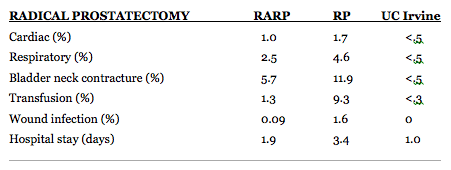Safety And Success
After Robot Assisted Radical Prostatectomy
The most important factor offered by the robot is a potentially safer operation with reduced risks of complications. No randomized prospective trials have been performed comparing standard open RP to RARP for a number of reasons. However, short of randomized control trials, the best way to analyze differences between the two approaches with the least amount of bias is large population based studies. In late 2007, Hu and colleagues published a landmark large population based study on 14,727 men undergoing radical prostatectomy over three years between 2003 and 2005. This study used computer generated claims (MarketScanR) which are based on procedure and complication specific codes. It encompassed all four major regions of the United States and included randomly urologists with high and low volume surgical practices. The study had a remarkable number of important findings. The percent of men undergoing RARP was just 5.4% in 2003 and rose to 24.4% by 2005. Further, in the early years, 2003, the need to convert from RARP to open RP was 28.6% and by 2005 this had dropped precipitously to 4.5%. It is now estimated that in 2009 more then 80% of men undergoing radical prostatectomy will have RARP. Table 1 provides a list of complications comparing RARP to RP taken from the report by Hu and associates and data from patients operated on at UC Irvine. It is divided into general complications associated with surgery and those unique to radical prostatectomy.
Table 1
Potential complications associated with radical prostatectomy

In addition to the findings in Table 1 there have been no deaths. There have been no venous thrombosis complications or PEs in over 700 cases and there have been no bladder neck contractures or strictures in over 350 cases. Common sense dictates that complication rates should vary from surgeon to surgeon and are technically related. That is - better technique, skill and experience does reduce the risk of complication. These findings have been confirmed in large population based studies by Hu and associates and Bianco and associates.
